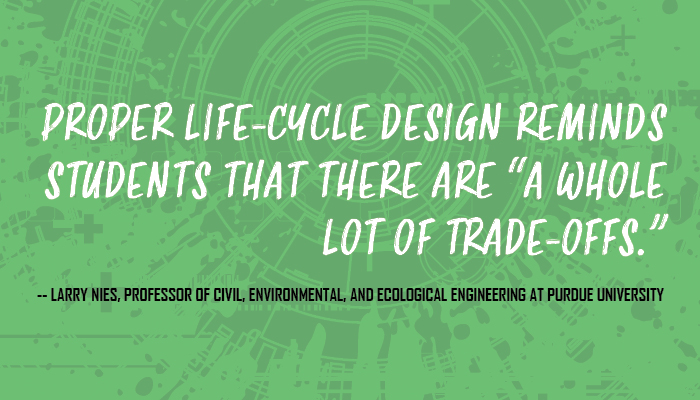Full Circle
Engineers are reimagining product design to reduce waste and protect the environment from planned obsolescence.
By Pierre Home-Douglas
When chemist Leo Baekeland invented the world’s first synthetic plastic in 1907, he could not have predicted Bakelite’s widespread use or the central role it would play in the emerging electrical and automobile industries. Nor could he have envisioned how profoundly polyethylene, polyvinyl chloride, and other advanced plastics would transform modern life—for better or worse.
The same versatile materials that now enhance products from tea bags to bulletproof vests also turn up in oceans, landfills, drinking water systems, and even our bodies. Society literally is saturated with the detritus of outdated, out-of-fashion, or worn-out manufactured goods.
Some engineering educators are reimagining product design and emphasizing “cradle to cradle” rather than planned obsolescence. Some are incorporating end-of-life plans into introductory design courses. Others teach specialized electives on eco-friendly manufacturing. The goal: factor life-cycle issues into every aspect of production.
Ma Bell’s Past Model
If history is any guide, shifting practice will involve complex variables, unanticipated consequences, and “a whole lot of trade-offs,” says Larry Nies, a professor of civil, environmental, and ecological engineering at Purdue University who teaches life-cycle design. In the working world, decisions are rarely clear, easy calls. Nies gives the example of a manufacturer weighing whether to use a fossil- or plant-based cutting fluid in its operations. The one made from petroleum distillates is generated from a nonrenewable resource, he notes, but the other “comes from an agricultural crop, and harvesting that crop emits a whole bunch of 2.5-micron particulate matter.”
“On the surface it’s very simple: you should design for recycling and refurbishment,” concurs Braden Allenby, a professor of ethics and engineering at Arizona State University’s School of Sustainable Engineering and the Built Environment. “But as soon as you start talking about implementation and trade-offs, it gets a lot more complicated.”
Allenby points to the Bell System’s telephones as the best recycling system that ever existed in the United States. The handsets were designed for robustness, and a single entity controlled their entire life cycle. Bell supplied the phones along with local service; customers returned their old models and received the latest version. When antitrust legislation dismantled the Bell System in 1982, “you broke up that recycling system” and its “end-of-life considerations,” Allenby says. “That replicates in many different ways today across the industrial ecosystem.”
New School of Thought
Unfettered by industrial constraints, engineering schools are uniquely positioned to address the ecosystem’s sustainability challenges. The need to consider end-of-life issues has been integrated into main core courses such as introductory design, says Georgia Tech mechanical engineering professor Bert Bras, who teaches a specialty course on environmentally conscious design and manufacture.
Purdue’s Environmental and Ecological Engineering program focuses on teaching students to rethink the way they look at products—not just how well a device performs but also what happens when it reaches the end of its lifespan. The approach starts by asking if something can be repaired, thus extending its lifetime, explains Nies. The corollary: can we design products for repair?
Questions—and solutions—will vary by sector and ease of renovation. With electronics, for example, upgrades could entail adding chips or memory, notes Nies, while fixing faulty components so the product’s main body lasts longer might delay the onset of obsolescence.
Dismantling and remanufacturing pose a different set of difficulties. “How do we make fasteners that can be disassembled?” asks Nies. “If you bond them or glue them, then you have to cut it or break it instead of using snaps or screws. If you can take products apart, then you can perhaps find an aftermarket for the pieces.”
At Lafayette College, civil and environmental engineering professor Mary Roth helped design an introductory course module on life-cycle assessment (LCA). The course typically consists of two seven-week modules that students select from among eight or nine choices. Roth’s LCA curriculum examines the different environmental considerations in each phase of a product’s life cycle, from fabrication to disposal and recovery. “That analytical framework for sustainability can be employed in any context, and yet it is often left until senior year or graduate school,” Roth says. “The more we also incorporate this subject into coursework and projects with students, the more they realize it’s possible to incorporate sustainability considerations into design.”
Staplers Reimagined
Infusing this new lens on design into the curriculum can be accomplished in a variety of ways and will vary from campus to campus. Large universities may introduce case studies in big lecture classes, for instance, while private colleges might emphasize discussion. Some professors include hands-on projects that put sustainability at the heart of the design process.
The lowly stapler takes center stage in Bras’s innovative manufacturing course at Georgia Tech. He starts by holding one up in class and tasking students to take their own staplers apart at home. They must analyze and identify what materials their stapler is made from, weigh the parts, and figure out if anything can be salvaged from it. Then Bras asks the students to redesign the stapler with end-of-life firmly in mind. Bonus lesson: even a fully recyclable stapler may end up in the landfill due to the lack of processing facilities or profitability of recapturing the materials.
Michelle McRae, a 2017 mechanical engineering graduate of McGill University in Montreal, credits case studies with inspiring her thinking about sustainability and end-of-life considerations. She knew nothing about the closed-loop economy when she entered the program and recalls spending her first two years taking foundational courses that were “very heavy with physics and math.” Then, in her third and fourth years, the theoretical classes started introducing real-world applications. One thermodynamics class took a particularly memorable look at energy cycles—including what happens when a gas-powered engine’s nonrenewable fuel is replaced with alternatives that are not only sustainable but also recyclable, such as biodiesel or metal fuels.
“That was the first time I really started seeing the idea of recycling what we are using,” McRae says. She ended up spending two and a half years in her professor’s Alternative Fuel Lab researching the combustion of iron. “Once the iron is burned, its oxide can be filtered from exhaust gases, reduced, and burned again, resulting in a closed cycle with minimal greenhouse gas emissions,” McRae explains. “So sustainability and recycling ended up becoming a big part of my time at McGill—something I never imagined when I started studying engineering.”

Complex Systems
Some engineering disciplines lend themselves better to end-of-life analysis than others. As ASU’s Allenby points out, “You can talk about the life cycle of a router, but what is the life cycle of the internet? Or virtual reality? Or virtual servers?” End-of-life planning is only one of many environmental constraints, he underscores. For example, redesigning a phone to use the least amount of energy-intensive metal components as possible may reduce its recycling value.
University of Pittsburgh assistant professor of civil and environmental engineering David Sanchez acknowledges the complexities but also the imperative of end-of-life planning by kicking off his introductory Current Issues of Sustainability course with the United Nations’ 17 Sustainable Development Goals for 2030. The ambitious agenda, which includes vows to eliminate poverty, ensure access to clean water and sanitation, and decouple economic growth from environmental degradation, “is not an exhaustive list, nor is sustainability that simple,” he says. But the U.N.’s aspirational goals inspire all countries to work toward achieving local solutions that collectively can help humanity.
“We tell the kids right up front: there is no way that in one class we can make you an expert on every single sustainability topic in every context,” explains Sanchez, who also serves as the associate director of the university’s Mascaro Center for Sustainable Innovation. “What we do hope is to inspire you to look critically, under the hood a little more, to understand the nuances and types of trade-offs that are present in all sustainability challenges.” Bakelite’s inventor would appreciate the lesson: jewelry, radios, and other items made from his pioneering plastic have become popular collectibles and fetch top dollar on the resale market.
Pierre Home-Douglas is a freelance writer and frequent Prism contributor based in Montreal. Illustration by ASEE Senior Graphic Designer Francis Igot.
This post was excerpted from”Full Circle” in the November 2021 issue of ASEE’s Prism magazine. Read the full article.
Filed under: Special Features
Tags: ASEE Prism magazine, end-of-life product design, Engineering, Environmental Engineering, landfills, life cycle design, manufacturing, Pierre Home-Douglas, planned obsolescence, plastics, Pollution, product design, Recycling, reuse, Sustainability, sustainability engineering









